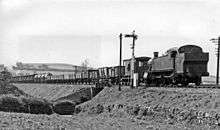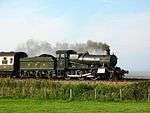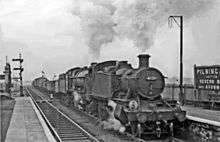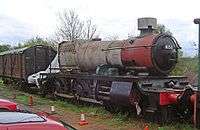GWR 5101 Class
The GWR 5101 Class or 'Large Prairie' was a class of 2-6-2T steam locomotives of the Great Western Railway.
| GWR 5101 Class | |||||||||||||||||||||||||||||||||||||||||||||
|---|---|---|---|---|---|---|---|---|---|---|---|---|---|---|---|---|---|---|---|---|---|---|---|---|---|---|---|---|---|---|---|---|---|---|---|---|---|---|---|---|---|---|---|---|---|
.jpg) 5164 at Totnes in 1958 | |||||||||||||||||||||||||||||||||||||||||||||
| |||||||||||||||||||||||||||||||||||||||||||||
| |||||||||||||||||||||||||||||||||||||||||||||
| |||||||||||||||||||||||||||||||||||||||||||||
| |||||||||||||||||||||||||||||||||||||||||||||
History

The 5101 Class were medium-sized tank engines used for suburban and local passenger services all over the Great Western Railway system. The class was an updated version, by Collett, of Churchward's 1903 3100/5100 Class.
The original 40 members of the 3100 class were renumbered 5100 and 5111 to 5149 in 1927. The first batches of 5101s filled in the numbers 5101 to 5110 and extended the class from 5150 to 5189. They were little changed from the Churchward locomotives as they then were, but had an increased axle loading of 17 long tons 12 cwt (39,400 lb or 17.9 t); the maximum permitted for the ‘Blue’ route availability. Bunkers were of the standard Collett design with greater coal capacity. The 5100 number series was exhausted in 1934, and further new locomotives were numbered from 4100. The last 20 were built after nationalisation.[1]
| Number | Date | Lot No | Notes |
|---|---|---|---|
| 5101-10 | 1929 | 257 | |
| 5150-59 | 1929 | 257 | |
| 5160-74 | 1930 | 259 | |
| 5175-89 | 1931 | 257 | |
| 5190-99 | 1934 | 284 | |
| 4100-09 | 1935 | 292 | |
| 4110-19 | 1936 | 292 | |
| 4120-21 | 1937 | 313 | |
| 4122-29 | 1938 | 313 | |
| 4130-39 | 1939 | 323 | |
| 4140-49 | 1946 | 335 | |
| 4150-59 | 1947 | 361 | |
| 4160-69 | 1948 | 369 | |
| 4170-79 | 1949 | 369 |
As both freight and passenger traffic on branch lines declined post-World War II with increasing volumes of private motor cars, and replacement on urban services by diesel-powered rail cars, the bulk of the class found itself allocated to various mainline support duties, mainly banking and piloting, often on the South Devon Banks on the Exeter to Plymouth Line, or around the Severn Tunnel on the South Wales Main Line.
A number of the class - 4110, 4115, 4121, 4144, 4150, 4156 and 4160 - ended their operational lives allocated to the major locomotive shed (88E) at Severn Tunnel Junction, undertaking piloting and banking duties through both the Severn Tunnel and the associated goods yard.[2] Assistance was needed by all heavy trains through the Severn Tunnel, which entailed: 3.5 miles (5.6 km) of 1-in-90 down to the middle of the tunnel; then a further 3.5 miles (5.6 km) at 1-in-100 up to Pilning; a short level then 3.5 miles (5.6 km) more at 1-in-100 to Patchway. However, the pilot locomotive usually came off at Pilning. Several of this group were sold for scrap to Woodham Brothers and consequently have survived into preservation.
Accidents and incidents
- On 30 November 1948, locomotive 4150 was running round its train at Lapworth when it was in collision with a passenger train hauled by 5022 Wigmore Castle, which had overrun signals.[3] Eight passengers were injured.[4]
Withdrawal
The below list shows when all of the original 5101's and later 4100's were withdrawn from service.
| Year | Quantity in service at start of year | Number withdrawn | Quantity withdrawn | Locomotive numbers |
|---|---|---|---|---|
| 1956 | 140 | 1 | 1 | 5159. |
| 1957 | 139 | 5 | 6 | 5107/09/56–57/61. |
| 1958 | 134 | 10 | 16 | 4138–39, 5105/08/60/62/65/68/71–72. |
| 1959 | 124 | 4 | 20 | 5170/86/89/96. |
| 1960 | 120 | 16 | 36 | 4162/64/70, 5102–04/06/10/50/55/63/69/78–79/85/97. |
| 1961 | 104 | 11 | 47 | 4117/23, 5158/66/74–77/94–95/98. |
| 1962 | 93 | 22 | 69 | 4102/06/12/16/18/26/29/45–46/52/63, 5151/67/73/80–83/87–88/90/93. |
| 1963 | 71 | 14 | 83 | 4114/19/27/34/40–42/49, 5101/52/54/64/92/99. |
| 1964 | 57 | 28 | 111 | 4101/03–05/08–09/20/22/24/28/30–33/35–37/43/53/59/66–67/71/73–74, 5153/84/91. |
| 1965 | 29 | 29 | 140 | 4100/07/10–11/13/15/21/25/44/47–48/50–51/54–58/60–61/65/68–69/72/75–79. |
Preservation
Ten of the class avoiding scrapping in the 1960s (six built in the 1930s before WW2 and four built after WW2 in the late 1940s, one of which under the British Railways banner). As of 2017, five have run in preservation, one is under active restoration, two are essentially in scrapyard condition and two have acted as donor locomotives for other projects:
| Number | Built | Withdrawn | Service Life | Owner | Current Location | Status | Notes | Image |
|---|---|---|---|---|---|---|---|---|
| 5164 | Nov 1930 | Apr 1963 | 32 Years, 5 months | 5164 Preservation Group | Barrow Hill Engine Shed | Boiler certificate expired 5 January 2014 | Normally located at the Severn Valley Railway, currently on display at Barrow Hill MPD for at least 12 months. | .jpg) |
| 5193 | Oct 1934 | Jun 1962 | 27 Years, 8 months | West Somerset Railway plc | West Somerset Railway | Operational (Donor locomotive) | Originally built in 1934, withdrawn in 1962 and recovered from Woodham Brothers scrapyard in 1979. Rebuilt by the West Somerset Railway into a 2-6-0 resembling a small boilered version of the GWR 4300 Class, which has been numbered 9351. Returned to service in 2019 following an overhaul. |  |
| 5199 | Nov 1934 | Mar 1963 | 28 Years, 3 months | Llangollen Railway | Llangollen Railway | Operational | Overhaul completed 23 November 2014 | |
| 4110 | Oct 1936 | Jun 1965 | 28 Years, 8 months | Dartmouth Steam Railway | East Somerset railway | Under restoration | Sold in May 2015 by GWR Preservation Group Limited of Southall Railway Centre to WSR plc. Moved to Minehead 16 June 2015. Sold in January 2019 to the Paignton and Dartmouth Steam Railway. On 10 January it was moved to the East Somerset railway for restoration to begin. There it will run for three years. | |
| 4115 | Oct 1936 | Jun 1965 | 28 Years, 8 months | Great Western Society | Didcot Railway Centre | Donor locomotive | Built October 1936, withdrawn from service in June 1965. One of the "Barry Ten", she was sold to the Great Western Society, Didcot in 2010, to act as a donor locomotive for the creation of two new locomotives:[5]
|
|
| 4121 | Dec 1937 | Jun 1965 | 27 Years, 6 months | Tyseley Locomotive Works | Unrestored, partially stripped | Stored at Tyseley in a partially stripped down state |  | |
| 4141 | Aug 1946 | Mar 1963 | 16 Years, 7 months | Epping Ongar Railway | Awaiting completion of repairs | Returned to steam in 2012 after an overhaul, but currently out of service awaiting boiler repairs. | ||
| 4144 | Sept 1946 | Jun 1965 | 18 Years, 8 months | Great Western Society | Didcot Railway Centre | Operational | Returned to steam in 2015 after an overhaul. On loan to the Kent & East Sussex Railway for the 2020 season. |  |
| 4150 | Jun 1947 | Jun 1965 | 17 Years, 11 months | 4150 fund | Severn Valley Railway | Restoration in progress |  | |
| 4160 | Sept 1948 | Jun 1965 | 16 Years, 8 months | 4160 Ltd | Llangollen Railway | Under Overhaul | Overhauled in 2007, operated on the West Somerset Railway. Sent to the Llangollen Railway in January 2016 for overhaul |  |
Models
Graham Farish manufacture a model of the Large Prairie in N scale. Hornby have manufactured a model of the class in 00 gauge in both Great Western and British railway liveries. Heljan are planning on producing a model of the large prairie in O gauge in 2017 [6]
See also
References
- http://www.greatwestern.org.uk/m_in_262.htm
- http://www.4150.org.uk/4150_history.html
- "Light at the end of the tunnel for Severn 'Prairie'". Steam Railway. Peterborough: Bauer Consumer Media Ltd (455): 40–42. 17 June 2016. ISSN 0143-7232.
- "Four killed and 50 injured in train crash". The Times (51243). London. 1 December 1948. col A-B, p. 4.
- "Frames Ordered for New GWR 47xx Class as Prairie Survivor is Dismantled". rail.co.uk. 8 March 2012.
- http://www.hornbymagazine.com/2016/11/21/first-painted-o-gauge-prairie/
External links
| Wikimedia Commons has media related to GWR 5101 Class. |